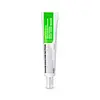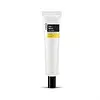What's inside
What's inside
 Key Ingredients
Key Ingredients

 Benefits
Benefits

 Concerns
Concerns

 Ingredients Side-by-side
Ingredients Side-by-side

Centella Asiatica Extract
CleansingWater
Skin ConditioningHydrogenated Poly(C6-14 Olefin)
EmollientGlycerin
HumectantCetyl Ethylhexanoate
EmollientCaprylic/Capric Triglyceride
MaskingCetyl Alcohol
Emollient1,2-Hexanediol
Skin ConditioningButylene Glycol
HumectantDipropylene Glycol
HumectantMethyl Trimethicone
Skin ConditioningPentaerythrityl Tetraisostearate
EmollientDipentaerythrityl Hexa C5-9 Acid Esters
Skin ConditioningPotassium Cetyl Phosphate
EmulsifyingSodium Hyaluronate
HumectantButyrospermum Parkii Butter
Skin ConditioningPanthenol
Skin ConditioningPalmitoyl Dipeptide-10
Skin ConditioningPalmitoyl Tripeptide-1
Skin ConditioningPalmitoyl Tetrapeptide-7
Skin ConditioningPalmitoyl Hexapeptide-12
Skin ConditioningPolyglyceryl-2 Stearate
EmulsifyingAsiaticoside
AntioxidantAsiatic Acid
Skin ConditioningMadecassic Acid
Skin ConditioningStearic Acid
CleansingGlyceryl Stearate
EmollientStearyl Alcohol
EmollientMacadamia Ternifolia Seed Oil
EmollientLimnanthes Alba Seed Oil
Skin ConditioningArgania Spinosa Kernel Oil
EmollientCaprylyl Glycol
EmollientCetearyl Olivate
Sorbitan Olivate
EmulsifyingCamellia Sinensis Extract
AntioxidantPancratium Maritimum Extract
BleachingAcetyl Glucosamine
Skin ConditioningCeramide NP
Skin ConditioningAcrylates/C10-30 Alkyl Acrylate Crosspolymer
Emulsion StabilisingAdenosine
Skin ConditioningTromethamine
BufferingCarbomer
Emulsion StabilisingDisodium EDTA
Lavandula Angustifolia Oil
MaskingCitrus Aurantium Bergamia Fruit Oil
MaskingCentella Asiatica Extract, Water, Hydrogenated Poly(C6-14 Olefin), Glycerin, Cetyl Ethylhexanoate, Caprylic/Capric Triglyceride, Cetyl Alcohol, 1,2-Hexanediol, Butylene Glycol, Dipropylene Glycol, Methyl Trimethicone, Pentaerythrityl Tetraisostearate, Dipentaerythrityl Hexa C5-9 Acid Esters, Potassium Cetyl Phosphate, Sodium Hyaluronate, Butyrospermum Parkii Butter, Panthenol, Palmitoyl Dipeptide-10, Palmitoyl Tripeptide-1, Palmitoyl Tetrapeptide-7, Palmitoyl Hexapeptide-12, Polyglyceryl-2 Stearate, Asiaticoside, Asiatic Acid, Madecassic Acid, Stearic Acid, Glyceryl Stearate, Stearyl Alcohol, Macadamia Ternifolia Seed Oil, Limnanthes Alba Seed Oil, Argania Spinosa Kernel Oil, Caprylyl Glycol, Cetearyl Olivate, Sorbitan Olivate, Camellia Sinensis Extract, Pancratium Maritimum Extract, Acetyl Glucosamine, Ceramide NP, Acrylates/C10-30 Alkyl Acrylate Crosspolymer, Adenosine, Tromethamine, Carbomer, Disodium EDTA, Lavandula Angustifolia Oil, Citrus Aurantium Bergamia Fruit Oil
Water
Skin ConditioningCaprylic/Capric Triglyceride
MaskingButylene Glycol
HumectantParaffinum Liquidum
EmollientGlycerin
HumectantNiacinamide
SmoothingPetrolatum
EmollientStearic Acid
CleansingBetaine
Humectant1,2-Hexanediol
Skin ConditioningGlyceryl Stearate
EmollientPEG-100 Stearate
Polysorbate 80
EmulsifyingCetearyl Alcohol
EmollientBeeswax
Emulsion StabilisingSorbitan Stearate
EmulsifyingSodium Hyaluronate
HumectantDimethicone
EmollientArginine
MaskingTocopheryl Acetate
AntioxidantCarbomer
Emulsion StabilisingMyrciaria Dubia Fruit Extract
Skin ConditioningEuterpe Oleracea Fruit Extract
Psidium Guajava Fruit Extract
AstringentMalpighia Emarginata Fruit Extract
Skin ConditioningAronia Arbutifolia Extract
Skin ConditioningLycium Barbarum Fruit Extract
AstringentGlycyrrhiza Inflata Root Extract
Skin ConditioningHamamelis Virginiana Extract
AntiseborrhoeicPanax Ginseng Root Extract
EmollientVaccinium Angustifolium Fruit Extract
Skin ProtectingPunica Granatum Fruit Extract
AntioxidantGalactomyces Ferment Filtrate
HumectantHydrolyzed Chitosan
Skin ConditioningRetinyl Acetate
Skin ConditioningAscorbic Acid
AntioxidantAllantoin
Skin ConditioningDisodium EDTA
Ethylhexylglycerin
Skin ConditioningParfum
MaskingWater, Caprylic/Capric Triglyceride, Butylene Glycol, Paraffinum Liquidum, Glycerin, Niacinamide, Petrolatum, Stearic Acid, Betaine, 1,2-Hexanediol, Glyceryl Stearate, PEG-100 Stearate, Polysorbate 80, Cetearyl Alcohol, Beeswax, Sorbitan Stearate, Sodium Hyaluronate, Dimethicone, Arginine, Tocopheryl Acetate, Carbomer, Myrciaria Dubia Fruit Extract, Euterpe Oleracea Fruit Extract, Psidium Guajava Fruit Extract, Malpighia Emarginata Fruit Extract, Aronia Arbutifolia Extract, Lycium Barbarum Fruit Extract, Glycyrrhiza Inflata Root Extract, Hamamelis Virginiana Extract, Panax Ginseng Root Extract, Vaccinium Angustifolium Fruit Extract, Punica Granatum Fruit Extract, Galactomyces Ferment Filtrate, Hydrolyzed Chitosan, Retinyl Acetate, Ascorbic Acid, Allantoin, Disodium EDTA, Ethylhexylglycerin, Parfum
 Reviews
Reviews

Ingredients Explained
These ingredients are found in both products.
Ingredients higher up in an ingredient list are typically present in a larger amount.
1,2-Hexanediol is a synthetic liquid and another multi-functional powerhouse.
It is a:
- Humectant, drawing moisture into the skin
- Emollient, helping to soften skin
- Solvent, dispersing and stabilizing formulas
- Preservative booster, enhancing the antimicrobial activity of other preservatives
Butylene Glycol (or BG) is used within cosmetic products for a few different reasons:
Overall, Butylene Glycol is a safe and well-rounded ingredient that works well with other ingredients.
Though this ingredient works well with most skin types, some people with sensitive skin may experience a reaction such as allergic rashes, closed comedones, or itchiness.
Learn more about Butylene GlycolThis ingredient is an emollient, solvent, and texture enhancer. It is considered a skin-softener by helping the skin prevent moisture loss.
It helps thicken a product's formula and makes it easier to spread by dissolving clumping compounds.
Caprylic Triglyceride is made by combining glycerin with coconut oil, forming a clear liquid.
While there is an assumption Caprylic Triglyceride can clog pores due to it being derived from coconut oil, there is no research supporting this.
Learn more about Caprylic/Capric TriglycerideCarbomer is a polymer of acrylic acid. Its main role is to create a gel consistency.
A high amount of carbomer can cause pilling or balling up of products. Don't worry, most products contain 1% or less of carbomer.
Disodium EDTA plays a role in making products more stable by aiding other preservatives.
It is a chelating agent, meaning it neutralizes metal ions that may be found in a product.
Disodium EDTA is a salt of edetic acid and is found to be safe in cosmetic ingredients.
Learn more about Disodium EDTAGlycerin is already naturally found in your skin. It helps moisturize and protect your skin.
A study from 2016 found glycerin to be more effective as a humectant than AHAs and hyaluronic acid.
As a humectant, it helps the skin stay hydrated by pulling moisture to your skin. The low molecular weight of glycerin allows it to pull moisture into the deeper layers of your skin.
Hydrated skin improves your skin barrier; Your skin barrier helps protect against irritants and bacteria.
Glycerin has also been found to have antimicrobial and antiviral properties. Due to these properties, glycerin is often used in wound and burn treatments.
In cosmetics, glycerin is usually derived from plants such as soybean or palm. However, it can also be sourced from animals, such as tallow or animal fat.
This ingredient is organic, colorless, odorless, and non-toxic.
Glycerin is the name for this ingredient in American English. British English uses Glycerol/Glycerine.
Learn more about GlycerinGlyceryl Stearate is a mix of glycerin and stearic acid.
It is used to stabilize the mixing of water and oil ingredients. By preventing these ingredients from separating, it can help elongate shelf life. It can also help thicken the product's texture.
As an emollient, it helps soften skin and supports barrier-replenishing ingredients.
In cosmetics, Glyceryl Stearate is often made from vegetable oils or synthetically produced.
This ingredient may not be fungal-acne safe
Fun fact: The human body also creates Glyceryl Stearate naturally.
Learn more about Glyceryl StearateSodium Hyaluronate is hyaluronic acid's salt form. It is commonly derived from the sodium salt of hyaluronic acid.
Like hyaluronic acid, it is great at holding water and acts as a humectant. This makes it a great skin hydrating ingredient.
Sodium Hyaluronate is naturally occurring in our bodies and is mostly found in eye fluid and joints.
These are some other common types of Hyaluronic Acid:
Learn more about Sodium HyaluronateStearic Acid is a fatty acid. It is an emollient, emulsifier, and texture enhancer.
As an emollient, stearic acid helps soften skin. It aids the skin's protective barrier by preventing water loss. It also provides a gentle cleansing effect without stripping away natural oils.
Stearic acid may also be used to enhance the texture of products. It can add volume and stabilize ingredients such as water and oil. This can help water and oil ingredients from separating.
Sources of stearic acid include animal or vegetable fats/oils such as coconut or shea. It can be naturally found in butter, cocoa butter, shea butter, vegetable fats, and animal tallow.
This ingredient may not be Malassezia folliculitis, or fungal-acne safe.
Learn more about Stearic AcidWater. It's the most common cosmetic ingredient of all. You'll usually see it at the top of ingredient lists, meaning that it makes up the largest part of the product.
So why is it so popular? Water most often acts as a solvent - this means that it helps dissolve other ingredients into the formulation.
You'll also recognize water as that liquid we all need to stay alive. If you see this, drink a glass of water. Stay hydrated!
Learn more about Water